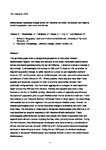Mediterranean landscape change during the Holocene: synthesis, comparison and regional trends in population, land cover and climate
| dc.contributor.author | Roberts, C Neil | |
| dc.contributor.author | Woodbridge-Fisher, J | |
| dc.contributor.author | Palmisano, A | |
| dc.contributor.author | Bevan, A | |
| dc.contributor.author | Fyfe, R | |
| dc.contributor.author | Shennan, S | |
| dc.date.accessioned | 2019-01-14T13:47:48Z | |
| dc.date.issued | 2019-05-01 | |
| dc.identifier.issn | 0959-6836 | |
| dc.identifier.issn | 1477-0911 | |
| dc.identifier.uri | http://hdl.handle.net/10026.1/13132 | |
| dc.description.abstract |
<jats:p>This synthesis paper offers a comparative perspective on how seven different Mediterranean regions, from Iberia and Morocco to the Levant, have been transformed by human and natural agencies during the past 10 millennia. It draws on a range of data sources: notably (1) archaeological site surveys ( n = 32,000) and<jats:sup>14</jats:sup>C dates ( n = 12,000) as proxies for long-term population change, (2) pollen records as a proxy for past vegetation and land cover ( n = 253) and (3) proxies, such as stable isotopes, from lake, cave and marine records as indicators of hydro-climate ( n = 47). Where possible, these data sets have been made spatially and temporally congruent in order to examine relationships between them statistically and graphically. Data have been aggregated or averaged for each region/sub-region and put into 200-year time windows. Archaeo-demographic data show a clear increase at the start of Neolithic farming, followed by a series of regionally asynchronous fluctuations in population, prior to a pan-Mediterranean Roman settlement maximum. Pollen data indicate a late-Holocene decline in %Arboreal Pollen in those regions that were initially well wooded, but not in drier regions of the southern/eastern Mediterranean. Overall, the clearest palynological proxy for human land cover change is provided by the OJCV (tree crop) index. The cultivation of these trees in the eastern Mediterranean after 6500 cal. yr BP may have been an adaptive response to mid-Holocene climatic desiccation. These anthropogenic pollen indicators correlate more closely with trends in population than with regional hydro-climatic z scores, implying that they reflect primarily human activities. During the mid Holocene, most Mediterranean landscapes were transformed by a combination of climate and rural land use, but after ~3500 cal. yr BP, human actions became increasingly dominant in determining land cover. During the past 1500 years, the dominant landscape trajectory in the eastern Mediterranean was markedly different to that in the central/western Mediterranean.</jats:p> | |
| dc.format.extent | 923-937 | |
| dc.language | en | |
| dc.language.iso | en | |
| dc.publisher | SAGE Publications | |
| dc.subject | archaeo-demography | |
| dc.subject | Holocene | |
| dc.subject | hydro-climate | |
| dc.subject | Mediterranean | |
| dc.subject | pollen | |
| dc.subject | tree crops | |
| dc.title | Mediterranean landscape change during the Holocene: synthesis, comparison and regional trends in population, land cover and climate | |
| dc.type | journal-article | |
| dc.type | Journal Article | |
| plymouth.author-url | https://www.webofscience.com/api/gateway?GWVersion=2&SrcApp=PARTNER_APP&SrcAuth=LinksAMR&KeyUT=WOS:000468293200014&DestLinkType=FullRecord&DestApp=ALL_WOS&UsrCustomerID=11bb513d99f797142bcfeffcc58ea008 | |
| plymouth.issue | 5 | |
| plymouth.volume | 29 | |
| plymouth.publication-status | Published | |
| plymouth.journal | Holocene | |
| dc.identifier.doi | 10.1177/0959683619826697 | |
| plymouth.organisational-group | /Plymouth | |
| plymouth.organisational-group | /Plymouth/Admin Group - REF | |
| plymouth.organisational-group | /Plymouth/Admin Group - REF/REF Admin Group - FoSE | |
| plymouth.organisational-group | /Plymouth/Faculty of Science and Engineering | |
| plymouth.organisational-group | /Plymouth/Faculty of Science and Engineering/School of Geography, Earth and Environmental Sciences | |
| plymouth.organisational-group | /Plymouth/REF 2021 Researchers by UoA | |
| plymouth.organisational-group | /Plymouth/REF 2021 Researchers by UoA/UoA14 Geography and Environmental Studies | |
| plymouth.organisational-group | /Plymouth/Research Groups | |
| plymouth.organisational-group | /Plymouth/Research Groups/Centre for Research in Environment and Society (CeRES) | |
| plymouth.organisational-group | /Plymouth/Research Groups/Centre for Research in Environment and Society (CeRES)/CeRES (Reporting) | |
| plymouth.organisational-group | /Plymouth/Research Groups/Marine Institute | |
| plymouth.organisational-group | /Plymouth/Users by role | |
| plymouth.organisational-group | /Plymouth/Users by role/Academics | |
| dcterms.dateAccepted | 2019-01-04 | |
| dc.rights.embargodate | 2020-3-25 | |
| dc.identifier.eissn | 1477-0911 | |
| dc.rights.embargoperiod | Not known | |
| rioxxterms.versionofrecord | 10.1177/0959683619826697 | |
| rioxxterms.licenseref.uri | http://www.rioxx.net/licenses/all-rights-reserved | |
| rioxxterms.licenseref.startdate | 2019-05-01 | |
| rioxxterms.type | Journal Article/Review |


